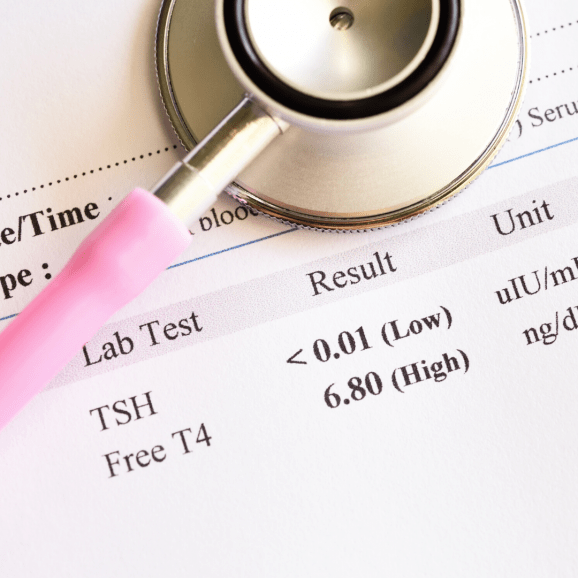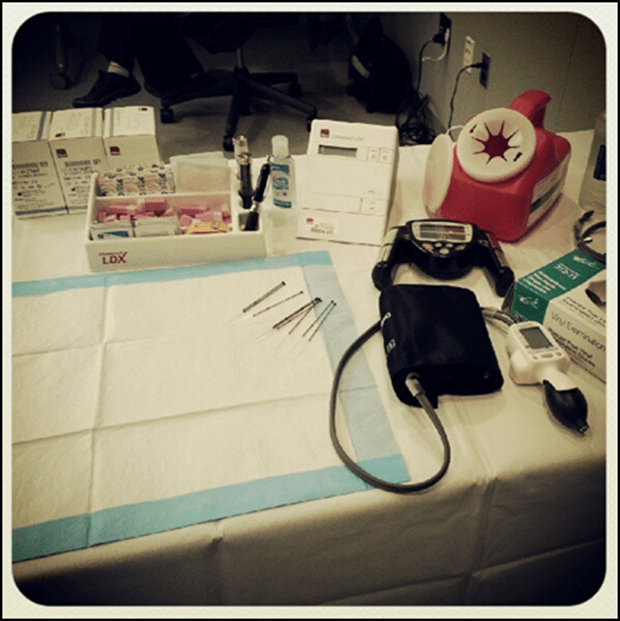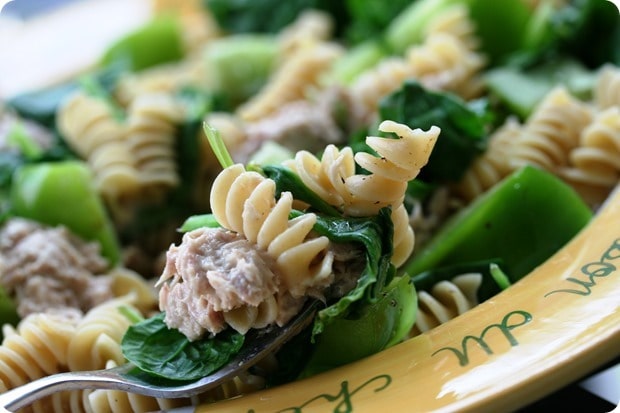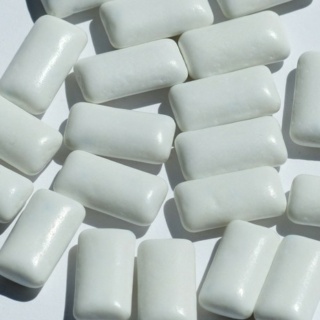Matt and I recently got routine blood tests done in order to get a discount on our health insurance, and when we got our results back, he mentioned how confusing they were. “I bet other people find this confusing, too,” he said. “You should write a blog post about how to interpret blood test results.” Great idea!
I learned quite a lot about blood tests and what all those numbers and acronyms meant when I was interning in a hospital during my masters program. I also spent some time during my corporate wellness internship working as a screener at office wellness events, which meant I did a finger prick test on participants, took a small sample of blood, and used a machine to check their cholesterol, glucose, and triglyceride levels. I also checked their blood pressure and took measurements like height, weight, waist circumference, body fat %, etc.
It’s so important to understand what all these different numbers and acronyms mean and how they impact your health. Here are some common labs you’ll see on a blood test, what they mean, what ranges are normal, and what to do if they aren’t.
**Just a note that I am not a doctor, and this post does not replace advice from your doctor or personalized nutrition counseling –with a dietitian that has your medical records and knows your personal history. Try everything I share at your own risk, and only after checking with your doctor. If your levels of any of these are high, your doctor is the first place to start! Also, these reference range numbers only apply to the U.S. – other countries may measure labs differently.**
TRIGLYCERIDES
Normal range: <150 mg/dL; Borderline high: 150–199, High: 200-499, Very high: >500Triglycerides are a type of fat found in your blood; the level of triglycerides in your blood can indicate how effectively you process the fat in your diet. When you eat, your body converts calories it doesn’t need to use right away into triglycerides, which are stored in your fat cells until needed for energy between meals. If you consistently eat more calories than you burn, this can cause high triglycerides (hypertriglyceridemia), which are a risk factor for heart disease.
Lifestyle changes to make if it’s high:
- Reduce refined carbohydrate and added refined sugar intake (e.g. white flour, processed foods, packaged desserts, etc.)
- Eat more omega 3 fatty acids. These are found in fish like salmon (favorite recipes: Pesto Baked Salmon, Salmon & Vegetable Egg Casserole), tuna (try my Black Pepper Crusted Yellowfin Tuna or Healthy Tuna Salad), or sardines (how to make sardines taste good), as well as grass-fed (vs. grain fed) meat, chia seeds, flaxseed, and walnuts.
- Cool it on the alcohol.
- Start (or be more consistent with) exercising.
TOTAL CHOLESTEROL
Optimal: <200 mg/dL; Borderline high: 200-239; High: >240
Cholesterol is a fat-like substance that’s found in all cells of the body; even though it’s often demonized, it actually is quite vital to health! Your body needs cholesterol to make hormones, Vitamin D, and to digest food; the body can make all the cholesterol it needs, although there is also some cholesterol found in food.
Cholesterol travels through the bloodstream in small packages called lipoproteins. There are two kinds of lipoproteins that carry cholesterol: low-density lipoproteins (LDL) and high-density lipoproteins (HDL).
LDL CHOLESTEROL
Optimal: <129 mg/dL; Borderline high: 130-159; High: 160-189; Very high: >190
LDL cholesterol is usually called “bad” cholesterol, because a high level leads to a buildup of cholesterol in your arteries, which are blood vessels that carry blood from your heart to the body (and obviously shouldn’t be blocked by buildups).
HDL CHOLESTEROL
Optimal: >60 mg/dL; Poor: <40 (men) and <50 (women)
HDL cholesterol is often referred to as “good” cholesterol, because it carries cholesterol from other parts of your body back to the liver, where it is disposed of.
What’s the deal with all these numbers?
Recent studies are indicating that high total cholesterol might not be a problem after all, especially if the two types of cholesterol (LDL and HDL) are in balance and there are not an abundance of small, dense LDL. After all, cholesterol is vital for a number of body processes, including production of hormones and healthy cell formation. Some studies even show that higher cholesterol can correlate with a lower risk of heart disease, and a recent study from UCLA found that the majority of heart attack patients (75%) admitted to their hospital did not have high total cholesterol – but they did have metabolic syndrome, which is the name for a group of risk factors that increases your likelihood of heart disease. (One of these risk factors is high triglycerides; the others include hypertension (high blood pressure), high fasting blood sugar, abdominal obesity, and low HDL (“good” cholesterol).
Save the eggs! It is often recommended to avoid egg yolks if you have high cholesterol – this is not advice I agree with, especially given recent research. It appears excess carbohydrates, especially those that are processed/refined, actually increase your cholesterol more than dietary cholesterol intake does. Plus – those yolks have a lot of really great nutrients in them (like Vitamin D)! And as for saturated fat, research has shown that when people with high LDL cholesterol purge their diet of saturated fats, they lower one kind of LDL, but not the small, dense particles that are linked to high carbohydrate intake and are implicated in heart disease. There is also a lack of concrete evidence showing that saturated fat intake (from real, unaltered sources – e.g. unprocessed food/animal products) leads to heart disease or increased mortality.
Lifestyle changes to make if your total or LDL cholesterol are high and/or your HDL is low:
- Eliminate trans fat (here’s a blog post about what is trans fat and how and why to avoid it) – this has been shown to increase LDL, decrease HDL, and up risk for diabetes, heart disease, and cancer – yikes.
- Reduce refined carbohydrate and added refined sugar intake (e.g. white flour, processed foods, packaged desserts, etc.)
- Start (or be more consistent with) exercising!
- Eat more fiber-rich foods (like fruit, vegetables, and whole, unrefined grains). Dietary fiber reduces cholesterol because it carries some cholesterol out of the body with it.
FASTING BLOOD GLUCOSE
Ideal range: 70-99 mg/dL; Prediabetes: 100-125; Diabetes: >126Glucose is a type of sugar that serves as the main source of energy for your cells, and this test will screen for problems in the way your body processes sugar. When you eat carbohydrates, your body will absorb glucose from the food, which increases your blood sugar. The body uses what is needs and stores some for later, too, and when it’s done, your blood sugar should go back to normal. The problem is that sometimes this system can go a little haywire, particularly (in the case of Type 2 Diabetes, which is heavily lifestyle-related, unlike Type 1 Diabetes, which is an autoimmune disease) if you eat a large amount of sugary, processed foods, do not exercise, and are overweight. A fasting (meaning you haven’t eaten in 8+ hours) glucose level above normal ranges is called hyperglycemia and may suggest diabetes. If you have hyperglycemia, this means that your body is either not correctly producing or using insulin, which is a hormone that enables your body to use glucose.
If your fasting blood glucose is high, the first thing to do is talk to your doctor about whether medication is necessary. In terms of lifestyle changes, here are some things to do that will help if you have (or are at risk for) Type 2 Diabetes:
- Start exercising. (You saw this coming!)
- Make sure that you are pairing carbohydrates (e.g. fruit, bread, grains, starchy vegetables like potatoes) with protein (meat, fish, eggs, etc.) and healthy fat (nuts, seeds, oils, avocado). The blood sugar rise effect from carbs will be slowed and mitigated a bit by the presence of protein and fat. Plus, pairing those three things will help greatly with satiety!
- Reduce stress (stress can mess with glucose levels).
- Sleep more (not getting enough sleep can mess with glucose levels AND increase cravings for sugary food – double whammy).
Related: While we’re talking about diabetes, a lab that is particularly helpful for determining your long term blood sugar control is Hemoglobin A1C (abbreviated HbA1c). Hemoglobin is a transport protein that carries oxygen through your blood. Glucose (sugar) in the blood after you eat normally becomes stuck to hemoglobin molecules, which are called glycated hemoglobin. Normal levels of glucose produce a normal amount of glycated hemoglobin, but as the average amount of blood glucose consistently increases, so does the amount of glycated hemoglobin, which serves as a marker for average blood glucose levels over the 2-3 months prior to the measurement. Normal range s: If you have diabetes, the HbA1c goal is <7%. For people WITHOUT diabetes: 4% – 5.6%. Increased risk for diabetes: 5.7% – 6.4%. Levels of >6.5% indicate diabetes. The higher the HbA1c, the greater the risk of developing complications related to diabetes.
BLOOD PRESSURE
Ideal range: <120/80 mm Hg. Prehypertension: 120-139/80-89, Hypertension stage 1: 140-159/90-99, Hypertension stage 2: >160/100. Emergency: >180/110.Blood pressure is the pressure being exerted on the walls of blood vessels/arteries by circulating blood. The top number in blood pressure readings refers to your systolic blood pressure, which measures the pressure on the arteries when your heart beats (contracts). The bottom number, diastolic blood pressure, measures the pressure when your heart relaxes (in between beats). If your blood pressure reading is high, it does not necessarily mean that you have high blood pressure – blood pressure can change quickly due to exercise, stress, sleep, and even posture – but your doctor will likely want to take more readings over time. If readings stay high over time, then that will indicate hypertension (which is a fancy word for high blood pressure – hypotension is the term for low blood pressure).
High blood pressure results from a combination of things, but being overweight and inactive are among the biggest factors that you can do something about (genetics, age, and race are also factors).
Lifestyle changes to make if it’s high (after talking to your doctor and seeing if medication is necessary):
- Start exercising (or do it more frequently – see the end of this post for a link to a post about how to not hate exercise).
- Reduce the amount of salt in your diet. I’m not a dietitian that is overly concerned with salt intake, and I don’t recommend obsessively tracking milligrams of sodium – the main thing you should do here is to reduce your intake of processed foods. If you eat real, minimally processed food you won’t need to worry about salt, because the main high sodium offenders are processed foods like frozen dinners or canned soup. If you do buy a packaged product, look for a low sodium version, and make sure the ingredients label is short and filled with things you understand. (See also: How to Add Flavor to Meals Without Sugar or Salt)
- If you smoke, stop. (!)
- Maintain (or get to) a healthy weight.
- Decrease alcohol consumption (to no more than 1 drink per day, maximum. If you are already consuming less than this, great!).
ANEMIA-RELATED MEASURES
(CBC, Hemoglobin, Hematocrit, MCV, Serum Ferritin, B12, Folate)These tests are all related to anemia, which is a condition that develops when the body does not have enough healthy red blood cells or hemoglobin, resulting in your cells not getting enough oxygen. If you are anemic, you will feel lethargic and tired.
Anemia can be caused by several factors, including blood loss (which is why women of childbearing age are more susceptible to being anemic), decreased or faulty red blood cell production, or destruction of red blood cells.
One of the most common types of anemia is iron-deficiency anemia, which can result from the following (in addition to some digestive conditions, surgical removal of the stomach/intestine, and certain drugs):
- An iron-poor diet (especially common when you are growing because your needs are higher (infants, children, teens), or if you are vegan or vegetarian because animal products are the best sources of dietary iron)
- Pregnancy/breastfeeding (the metabolic demands for iron are higher)
- Menstruation (because you are losing iron in your blood)
- Endurance training (the stress you are putting your body requires extra iron. This is why anemia is common in runners! And why you sometimes crave a burger or steak after a long run.)
Another common type of anemia is vitamin-deficiency anemia, which can occur when dietary vitamin B12 (found in animal products like meat) and folate (found mostly in legumes and veggies) are deficient, as these two vitamins are needed to make red blood cells.
This sounds complicated – how do I know if I’m anemic?
Your doctor may do a Complete Blood Count, or CBC, which measures different parts of your blood, like the number of red blood cells, white blood cells, and the platelets in your blood. The CBC also measures your hemoglobin and hematocrit levels. Hemoglobin, like I mentioned previously, is an iron-rich protein in red blood cells that carries oxygen through the blood. Hematocrit measures how much space red blood cells take up in your blood.
The CBC also looks at Mean Corpuscular Volume (MCV), which is a measure of the average size of your red blood cells – this result can give an indication as to the cause of the anemia. (In iron-deficiency anemia, for example, red blood cells are usually abnormally small.)
If the CBC results confirm you have anemia, then you usually have other tests done to find out what is causing it and how severe it is. These tests include serum ferritin, which measures how much iron is stored in your body’s tissues, not just in your blood.
I’m anemic – now what? Beyond supplementation (talk to your doctor to see if that is necessary), here are some dietary recommendations:
- If your anemia is caused by iron-deficiency, eat more foods that are rich in iron. Iron from animal sources, like meat and fish, is better absorbed – but nonmeat foods like legumes, tofu, dried fruits, leafy greens, and iron-fortified breads and cereals also contain some iron.
- Pair iron-rich foods with those that contain vitamin C (e.g. citrus fruits and vegetables) – the presence of vitamin C enhances absorption of iron. Example: squeeze some lemon on your sauteed spinach and/or steak. My Orange Lemon Chicken recipe is another good option here, as is a simply baked fish in foil topped with some lemon juice, lemon slices, herbs, and olive oil.
Another test worth mentioning:
- Vitamin D (25-hydroxyvitamin D) – This isn’t normally included on a routine blood test, but it’s worth having it tested, especially since many people are deficient nowadays. If your levels are low (<20 ng/mL), it manifests in feeling sluggish and achy, and can also lead to more serious conditions like osteoporosis and other bone problems. Depending on the severity of the deficiency, supplementation might be required, but your body can also make Vitamin D itself from the sun if you get enough sunshine – so get outdoors! In terms of food, naturally Vitamin D rich options include egg yolks (again, save the eggs!) and fatty fish (tuna, mackerel, salmon, sardines). In addition, milk and soymilk are often fortified with added Vitamin D.
And there you have it! I tried hard to include some good, concrete information about what all this stuff meant without getting TOO technical or overwhelming, so I’m hoping I succeeded and you found this at least a little bit helpful. Bookmark it for future reference and stay healthy, my friends! Here are some other posts you might find helpful:












